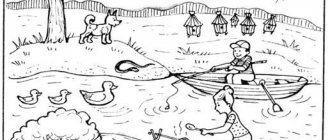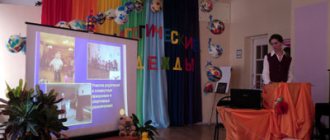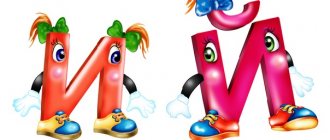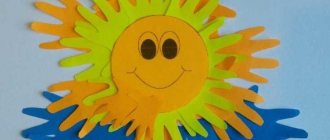Summary of the integrated lesson. “My Family” (speech therapy group)
Transcript
1 Summary of the integrated lesson “My Family” (speech therapy group) 1
2 Summary of an integrated lesson on the topic: “My family.” Program content: To form an idea of a family as people who live together; activate the vocabulary based on deepening knowledge about one’s family, expand children’s understanding of the family as people who live together, clarify the concepts of “family”, “relatives”; teach how to build a family tree, helping the child to understand himself as a particle involved in the history and life of the family. Foster a sense of respect for older family members, a desire to help those who need it, take care of them. Materials and equipment: figurines depicting family members, pictures of clouds and the sun, a house model, flat images of trees, a set of circles to depict the faces of grandmother, grandfather, father, mother for each child, colored pencils, glue, napkins, ball. Preliminary work. Children's drawings on the theme “My Family”; discussion of proverbs about family; role-playing game “Family chores”, “Travel by train with the whole family”, examination of the album “Our Family”. Course of the lesson 1.Org.moment - Children, I invite you to visit the boy Petya. And he lives in this beautiful house. (draws the children’s attention to the layout of the house). (Slide1,2) 2. Guessing riddles. - To find out who Petya lives with, we need to solve riddles. 1. Before going to bed, putting on pajamas, We ask (mom) to read (Slide 3) 2. Fragrant jam, Pies for a treat, Delicious pancakes For our beloved (grandmother) (Slide 4) 2
3 3. He did not work out of boredom, His hands are calloused, And now he is old and gray-haired My dear, beloved.. (grandfather) (Slide 5) 4. Who will teach you how to hammer a nail, Will let you steer the car And tell you how to be brave, Strong, dexterous and skillful? You all know, guys, - This is our favorite.. (dad) (Slide6) 5. Who is the cheerful little one - crawls quickly on his belly? Amazing boy - This is my youngest..(brother) (Slide 7, 8) 6. Who loves both me and his brother, But loves to dress up more? A very fashionable girl. My little sister (Slide9) - That’s how big Petya’s family is. Look carefully, who else have we forgotten about? (draws the children’s attention to the attic window where the cat Murka sits). Do you think Murka is also Petya’s family? (Children's reasoning) A cat is a beloved pet, but not a family member. Murka has his own family: a cat and small kittens. - So, what is family? (Children's answers) 3. Didactic game "Fourth Extra" To clarify who is a member of the family, Petya suggests playing the game "Fourth Extra". The task is: determine which of these people is not a relative? * Mom, neighbor, grandmother, sister. * Grandmother, friend, sister, mother. * Sister, salesman, grandmother, brother. * Janitor, brother, dad, grandfather. * Grandfather, dad, driver, father. 3
4 - Why does a person need a family? (To be loved, pitied, praised, taught how to live.) - How should people treat each other in a family? (Be friends, love, look after, protect.) 4. “Make a portrait of your family” - Petya really wanted to know about your families, tell us, guys. (Children are invited to draw up a portrait of their family and talk about it.) Leading questions: - Who do you live with? —Who is the eldest in your family? - Who is the youngest? — How do you take care of your family members? - Do you love your loved ones? Why? - Well done! It’s good that there is a family where they love each other, help and take care of each other. — Do you like to help your loved ones? Let's check it now. 5. “Who, how to work?” And now I invite Petya to play a little with us and find out who works in your families. I will throw the ball to everyone in turn, and you will have to catch and agree: dad, mom, grandma, grandpa, sister, brother or me. For example, Who goes to work? finishes: Mom and dad: Teaches lessons: Sister, brother. : Washing dishes: Mom and grandma. : Master: Dad, older brother, grandfather. : Goes shopping : Grandma, mom, dad. : Cleans the house Child: Mom, sister, grandmother. 4
5 6. Physical exercise “Family exercise”. In autumn, spring, summer and winter, we go out into the yard as a friendly family. Let's stand in a circle and in order. Everyone does exercises. Mom raises her hands, Dad cheerfully crouches. Turns right and left. My brother Seva does it. I jog myself and shake my head. 7. D/i “Sun and Cloud”: - Guys, how do we express love for our loved ones? (children's answers) - That's right! We also do good deeds and never do bad ones, so as not to upset our parents. What do you think joy (sadness) looks like like the sun or like a cloud? (Every child has a sun and a cloud) I will name actions. If you think that this act will upset your mother, raise a cloud; if it pleases, raise the sun. — They painted a beautiful picture; — Got into a fight with a friend; — We ate semolina porridge; — Put the toys back in place; - They tore the book; — My jacket got dirty while out for a walk. - Guys, look at what a beautiful tree I want to give you. On this tree I depicted the entire pedigree of my family. I suggest you make the same kind of trees. Just so that you get a tree, let's see what it looks like. 9. Didactic exercise “What does it look like?” (Slide 10) - The tree has roots. Do you think the family has roots? Who is this? (Children: family roots are grandparents). They are the oldest members of the family, giving it its beginning. A tree trunk grows from the roots. It carries nutritious juices to the branches and leaves. These are your parents. They are young people, they work, they work, they take care of the younger and older ones. The twigs and leaves on our tree are children who reach out to the sun and love warmth and affection. In order for a tree to stand firmly, you need to take care of the roots. Love and care for older family members. 5
6: Many of you have brothers and sisters. Your moms and dads have them too, so a large family has always been depicted in the form of a tree, which is called a “family tree.” Let's make such a tree too. Just to get the job done, we need to stretch our fingers. 10. Finger gymnastics Family” Let's remember finger gymnastics about the family. This finger is grandfather This finger is grandma This finger is daddy This finger is mommy This finger is me That’s my whole family 11. Drawing up a “Family Tree” of your family. Today we will try to create such a tree of some kind. You have trees. First of all, you draw yourself on the circles. Then mom, dad, brothers, sisters, grandfathers, grandmothers. Children draw and glue the circles onto the tree. 12.Result of the lesson. Well, now each of you has your own family tree. - It’s so good that you all have a family! You are the happiest children in the world, because in your families they love each other, everyone lives cheerfully and amicably together. Families are big and small. The main thing is that there is always peace, friendship, respect, and love for each other in the family. 6
Topic: "Family"
Integration of educational areas: “Cognitive development”, “Socio-communicative development”, “Physical development”.
Software tasks:
Educational field “Speech development”:
- Expand the active and passive vocabulary of children on the lexical topic “Family”; acquaintance with family members: mother, father, brother, sister, grandmother, grandfather, aunt, uncle, grandson, granddaughter, son, daughter, their qualities, character traits, activities).
- Practice the practical use of the category T.p. with the preposition -s, nouns with a general meaning.
- Strengthen the ability to form and use nouns with diminutive suffixes in speech.
Educational area "Cognitive development":
- To form ideas about the composition of the family, to introduce family ties in the family (brother, sister, parents, grandmother, grandfather, son, daughter, grandson, granddaughter).
- Develop visual and auditory perception, attention, memory, coherent speech.
Educational field “Social and communicative development”:
- Continue to work on forming friendly relationships between children, the ability to work collectively.
Educational field "Physical development":
- Develop gross motor skills and fine motor skills of the hands.
Equipment:
- picture material on the topic, family photographs.



